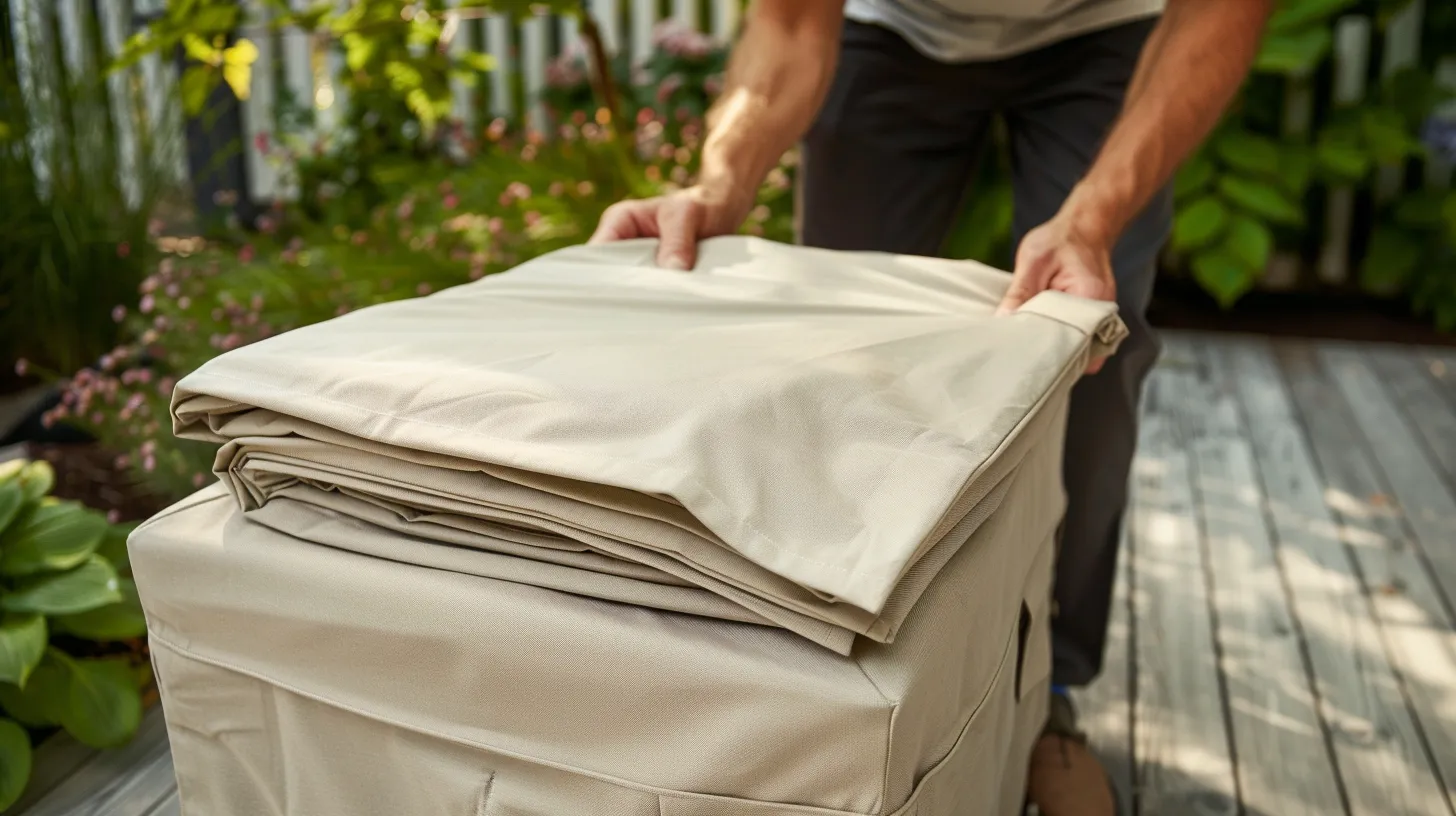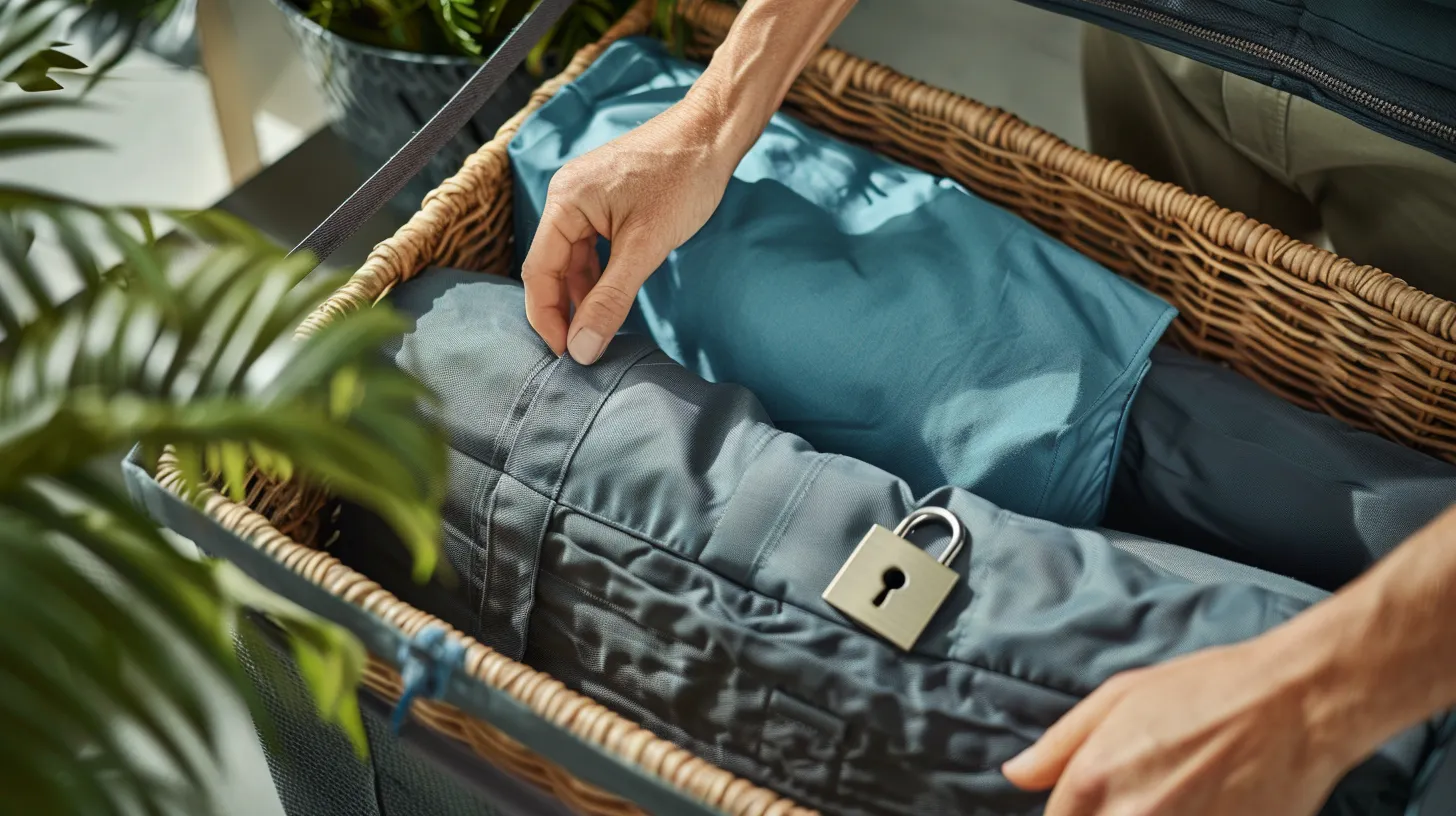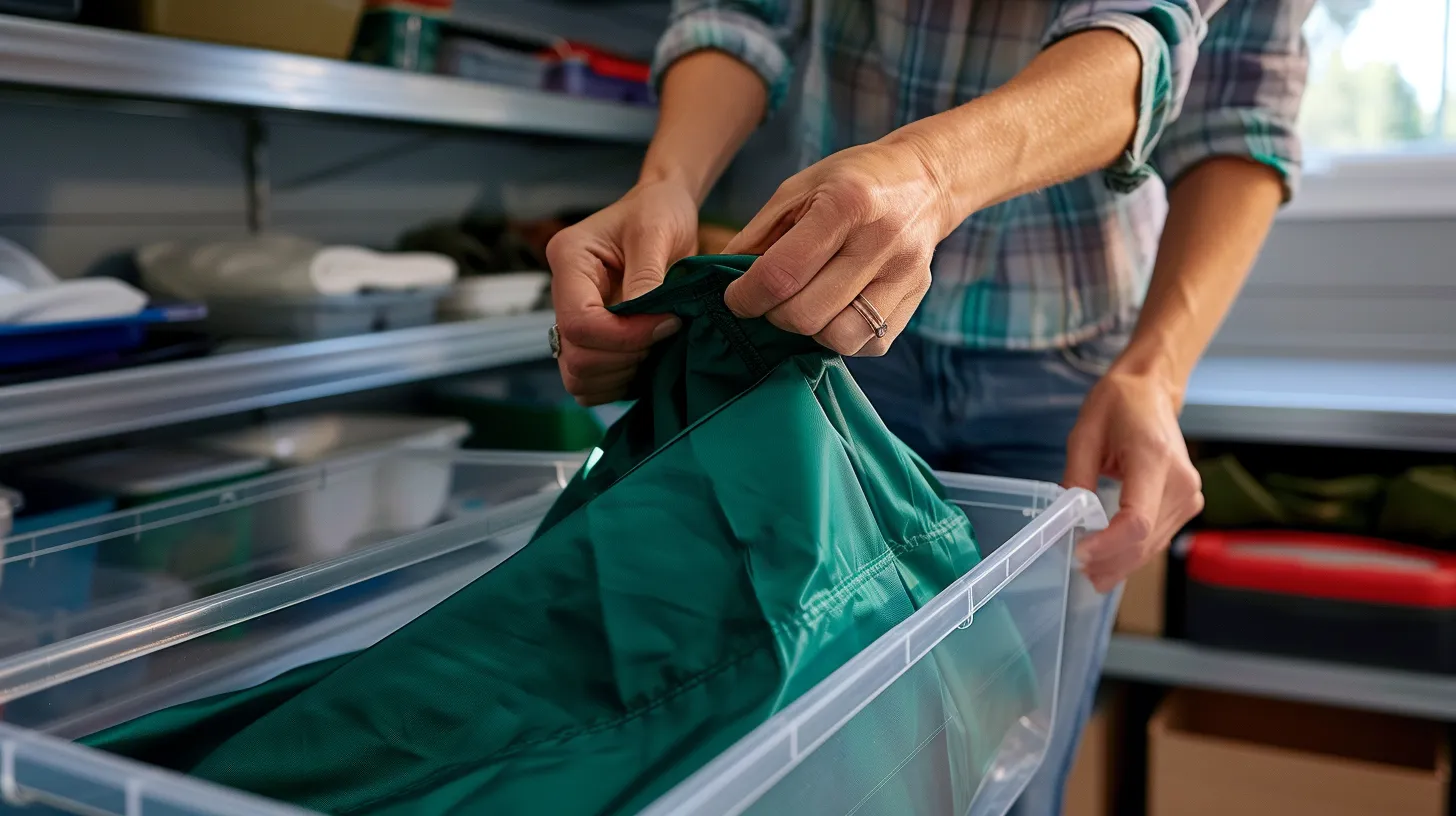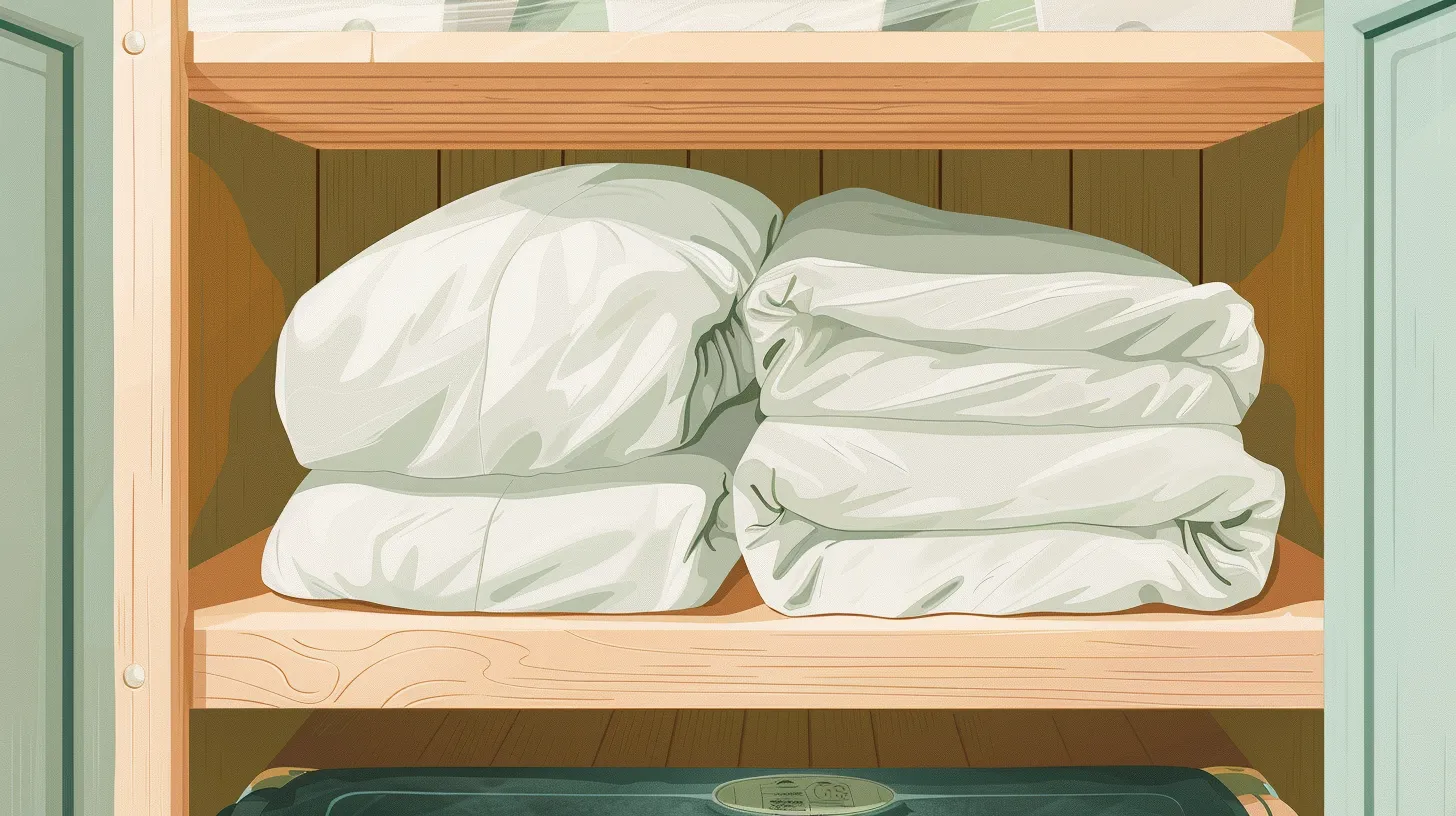To fold and store outdoor furniture covers efficiently, begin by ensuring the covers are completely dry to prevent mold or mildew. Lay each cover flat on a clean, dry surface, then align any elastic or angled sides and fold neatly in half, or consider rolling for larger covers. Store these neatly folded covers in waterproof, breathable containers , such as those made from nylon or polyester, and seal tightly to protect from contaminants. Tight sealing, alongside effective utilization of storage space, will assure the extension of your covers' lifespan. Exploring further will reveal effective ways to secure, maintain and keep your outdoor furniture covers clean and durable.
Cleaning Outdoor Furniture Covers

Before storing your outdoor furniture covers, it is important to thoroughly clean them to make sure they remain in top condition. Cleaning outdoor furniture covers might seem like a challenging task, but with the right tools and procedures, you can achieve this with ease.
First, shake off any debris from the covers. This step is vital because it prevents dirt from soaking into the fabric during the cleaning process. Next, hand wash the covers using a mild soap and warm water. A sponge or soft bristle brush is ideal for this task, as it can effectively remove dirt without causing damage to the material.
It's essential to make sure that the covers are completely dry before you proceed to the next steps. Importantly, storing damp or wet covers can lead to the growth of mold, which can significantly reduce their lifespan and overall quality.
Once the covers are clean and dry, fold them neatly on a flat surface. This not only saves space but also makes them easier to handle. Finally, store the folded covers in waterproof containers or storage bags to extend their lifespan. Choose a dry storage area to prevent any potential moisture buildup.
Drying Process for Covers

An important step in the maintenance of outdoor furniture covers is making sure they are thoroughly dry before storage , as this prevents the growth of mold and mildew . Properly drying outdoor furniture covers is vital for their longevity and best performance .
Begin the drying process by wiping down moisture-prone areas with a towel, ensuring they are completely dry . Special attention should be given to folds and gathered sections, as these areas tend to trap moisture and can foster the growth of mold and mildew if not properly dried.
Once the covers have been towel dried , allow them to air dry in a dry area . This step ensures that any residual moisture evaporates, leaving the covers completely dry. Air drying is a natural and effective method that helps maintain the integrity of the fabric while preventing mold and mildew growth.
Before folding and storing, verify that the covers are completely dry. This step is essential to prevent the growth of mold and mildew, which can damage the covers and make them unsuitable for use. Always remember to store the outdoor furniture covers only when they are completely dry to ensure their longevity and effectiveness.
Techniques for Folding Covers

Properly folding your outdoor furniture covers is a crucial step that guarantees their safe storage and future usability. The first technique in the folding process involves laying the cover flat on a clean, dry surface . This establishes a solid foundation and ensures that no dirt or debris gets trapped within the folds.
Next, align the angled and elastic sides of the cover, squaring it up before you begin to fold. This alignment helps to maintain the shape of the cover and ensures a neat fold. To reduce the size and make the cover more manageable for storage, fold it in half . This simple folding technique not only makes the cover easier to handle but also helps to save space in your storage area.
Selecting Proper Storage Materials

Having established appropriate folding techniques, it's important to focus on the next step - selecting the right materials for storing your outdoor furniture covers. Vital storage not only saves space but also extends the lifespan of your covers.
The choice of storage bags is essential. Breathable materials such as nylon or polyester are recommended as they allow for effective air circulation, reducing the risk of moisture buildup and mildew. These materials are light yet durable, ensuring your furniture covers remain in good condition.
Further protection can be achieved with waterproof storage bags or bins. These safeguard your furniture covers from water damage, maintaining their quality and functionality. A protective spray may be used for added resilience against environmental elements.
Stackable storage containers make for a convenient organization, optimizing the use of your storage space. These containers should have sealing lids to protect from dust, dirt, and pests, which could otherwise deteriorate your covers.
Lastly, consider the ease of access and transport of your storage solutions. Lightweight containers or bags with handles simplify the process, making the storage and retrieval of your covers a less strenuous task. Remember, the right storage materials not only save space but also preserve your furniture covers, ensuring they serve you longer.
Making Use of Storage Spaces

Maximizing the use of available storage spaces is an important consideration when it comes to storing your outdoor furniture covers. The first step in utilizing these spaces effectively is to neatly store your folded covers. Using storage bags can facilitate this process, allowing a systematic arrangement that enhances easy access and retrieval.
For larger or bulky covers, consider the method of rolling covers. This technique not only makes the covers easier to handle but also helps to save space. It is recommended to use storage bags made of breathable materials such as polyester or nylon. These materials prevent moisture buildup, contributing to the longevity of your covers.
Ensuring your storage bags are sealed tightly is another vital step. This protects the covers from dust, dirt, and other potential contaminants. However, while ensuring a tight seal, make sure the bags are stored in a cool dry place. Exposure to sunlight can degrade the material quality over time, hence storing in a cool, shaded area helps maintain quality.
Utilizing Containers and Boxes

In addition to using storage bags, waterproof containers and boxes offer another highly effective solution for storing your outdoor furniture covers. These containers not only neatly store folded covers but also protect them from various damaging factors. Outdoor storage areas, for example, may expose your covers to dampness, substantially reducing their usability over time. Waterproof containers, however, provide a reliable shield against such issues, ensuring that your covers remain in the best possible condition.
Another consideration is the risk of rodents in storage areas. These creatures can chew through fabric, causing irreparable damage to your outdoor furniture covers. A sturdy container can prevent this, acting as a strong barrier against pests, thereby helping to extend the lifespan of your covers.
Moreover, using labeled containers can streamline your storage process. This allows you to easily identify and access specific covers when needed, saving you time and effort.
Lastly, containers can help you save space . By stacking them, you can maximize your storage area, keeping it organized and clutter-free . This way, you not only protect your outdoor furniture covers but also utilize your storage space effectively, extending the lifespan of your covers and contributing to a more orderly home.
Outdoor Cover Security Measures

To guarantee longevity and preserve the appearance of your outdoor furniture, implementing various security measures is essential. Using breathable fabrics , secure fastenings , and waterproof zippers for your covers can make a significant difference. These elements not only help extend the lifespan of your outdoor furniture covers but also maintain their aesthetic appeal.
Breathable fabrics with vents for cross ventilation should be your go-to choice to prevent mold and mildew, which can degrade the quality of your covers over time. Secure fastenings like drawstrings or elastic bands are crucial to ensure a snug fit , offering protection against wind and potential damage.
Adding to this, waterproof zippers add an additional layer of security and protection from the elements, preventing any water ingress that could potentially damage your furniture. To further prevent ballooning and ensure a secure fit, consider utilizing cover clamps specifically designed for outdoor furniture covers.
Proper securing of outdoor furniture covers not only helps in extending the lifespan of your furniture but also aids in maintaining its appearance. Furthermore, these measures can save space when the covers are not in use, as they can be folded neatly and stored in appropriate storage containers.
Maintenance and Care Tips
Building on the importance of proper securing, the maintenance and care of your outdoor furniture covers play a significant role in ensuring their durability and functionality .
The process begins with essential folding. Folding your furniture covers properly can prevent creases and potential damage, guaranteeing their longevity . Folding in half or thirds can make them more manageable, but it's vital to make sure that the fold lines are straight and the edges line up perfectly.
When folded neatly, covers are less likely to get tangled or take up excess space, thereby contributing to space saving in your storage areas. Remember, the neater your storage, the easier it is to locate and retrieve items when needed.
Storing your neatly folded furniture covers in waterproof containers or specially designed storage bags can protect them from potential damage. Waterproof containers safeguard your covers from water damage and other elements that could compromise their quality. This storage method further enhances space saving and contributes to the maintenance of your covers.
Preventing Mold and Mildew
While maintaining the physical condition of your outdoor furniture covers is vital, it's equally important to prevent the growth of mold and mildew , which can significantly affect their lifespan and functionality. These unwelcome organisms thrive in damp environments, thereby underscoring the need to make sure that your furniture covers are completely dry before storing them. It's imperative to prevent mold and mildew by storing your outdoor furniture covers in a cool, dry place .
The process of preventing mold and mildew begins with proper cleaning of the covers. By ensuring that they are thoroughly cleaned and completely dry before storage, you minimize the chance of mold and mildew development. Regular inspection of your stored covers is also critical to detect any early signs of mold or mildew growth, and any discovered should be addressed promptly to prevent further growth.
Hand Washing and Air Drying Techniques
Employing effective hand washing and air drying techniques is paramount to the longevity and performance of your outdoor furniture covers. To start, hand wash your covers using a mild soap and warm water. This mixture effectively removes dirt and grime that can deteriorate the fabric over time. Use a soft bristle brush or a sponge to gently scrub the covers, guaranteeing a thorough cleaning without damaging the material.
Rinsing should be done completely with a garden hose, effectively eliminating all soap residue and remaining dirt particles. Once washed, it's essential to air dry your covers in a dry area. This process wards off mold and mildew growth, a common problem that can result in significant damage to your covers if left unchecked.
The final step involves properly folding the covers . A correctly folded cover not only saves space, but also makes storage neat and orderly, facilitating easier retrieval for future use. In taking these steps, you ensure that your covers maintain their quality and durability , ready to protect your outdoor furniture whenever required. This process, although seemingly tedious, guarantees a longer lifespan for your covers, resulting in cost savings in the long run.










